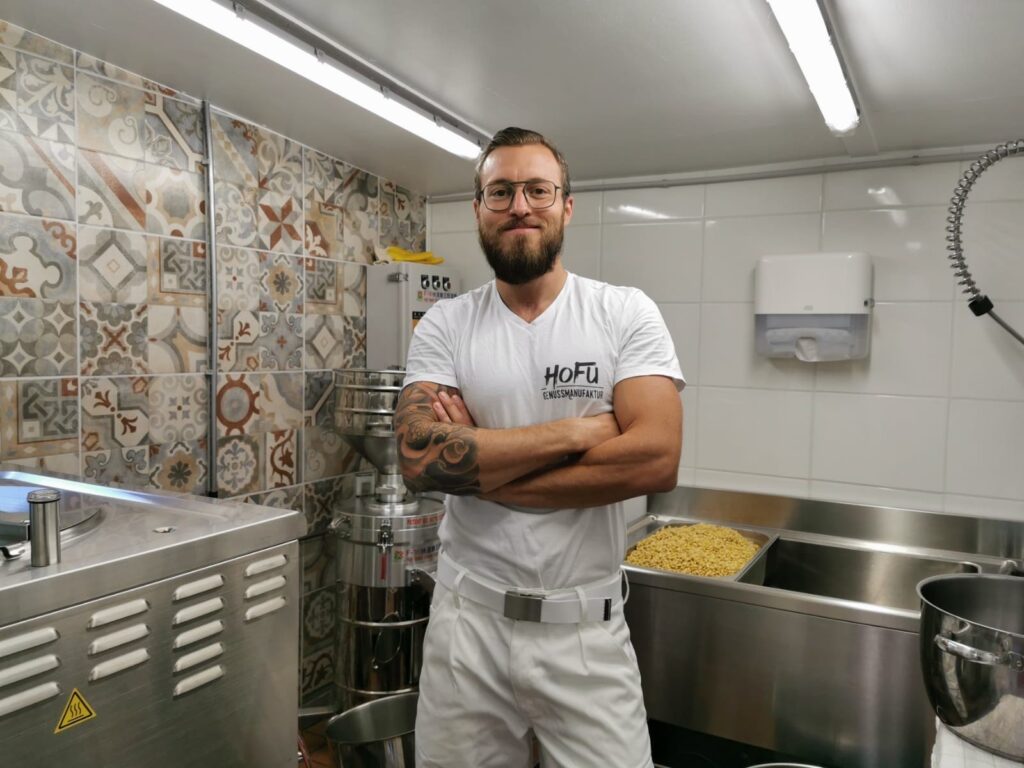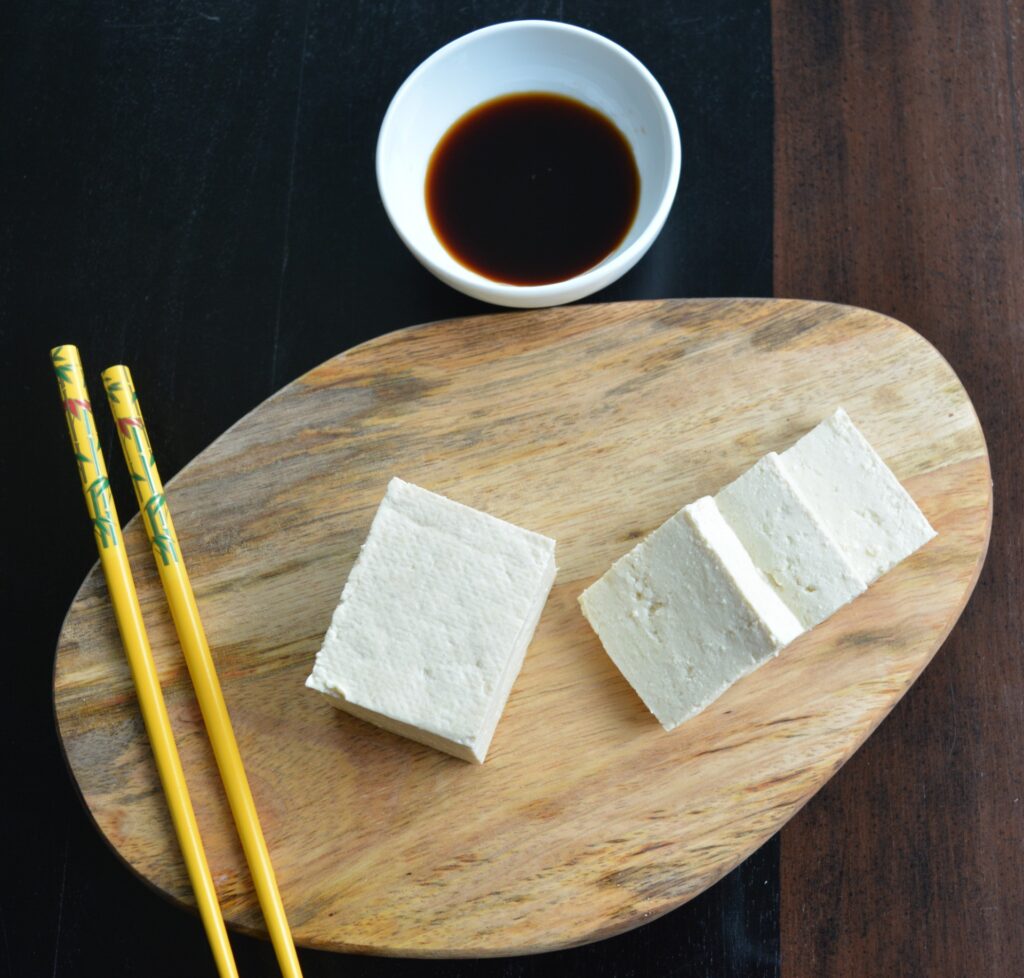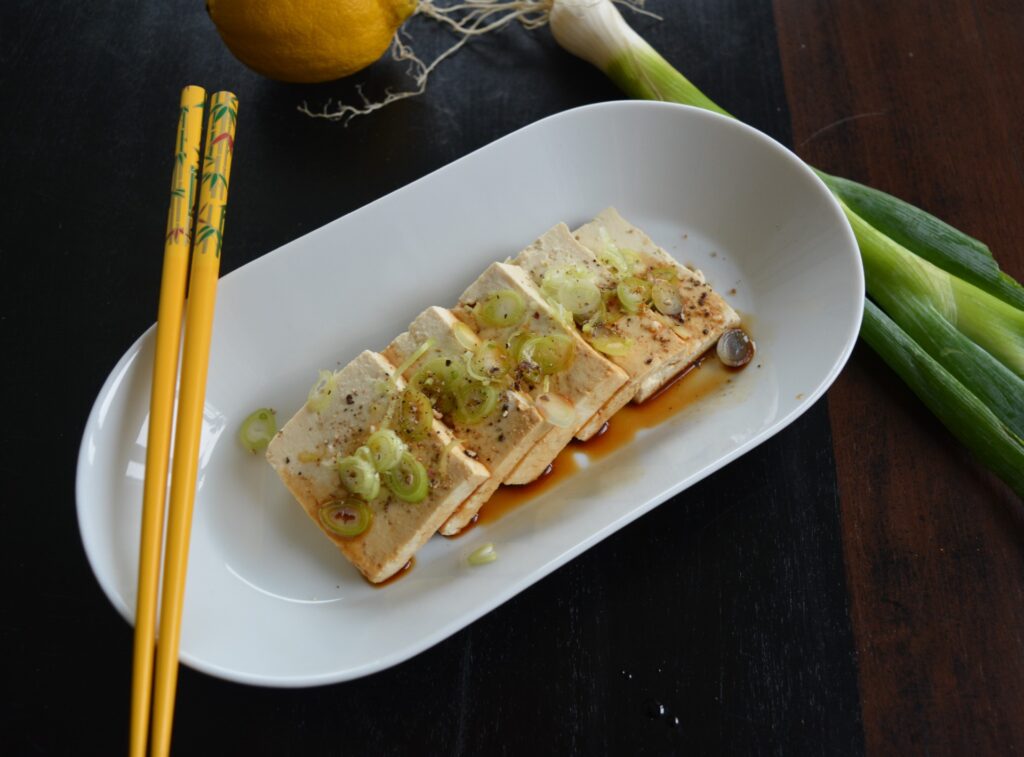What began as an experiment in his own kitchen has developed into a small but fine tofu factory. Mathias, founder of HOFU, started his first attempts to make tofu himself with a simple 20-liter pot during the coronavirus pandemic. Word of the idea spread quickly – friends and acquaintances tried his creations and the response was positive! As interest grew, Mathias took the next step: he bought a 70-liter machine, cleared out his old workshop and turned it into a small but professional production facility – with official approval from the food inspectorate, of course.
He has been making fresh tofu there regularly ever since. As he still has a full-time job, HOFU Genussmanufaktur is a passionate side project that provides fresh, handmade tofu every two weeks.

How did you come up with the idea of setting up a sustainable tofu factory?
Mathias: I’ve actually always paid a lot of attention to where my food comes from and how it’s put together: Because it often contains additives and simply lumpy stuff that doesn’t belong in there. The deciding factor was my vegan dietary change and a vacation in Italy: I went shopping in a normal supermarket and bought lots of fresh food and yet every day there was a bag of plastic waste left over. On the 3rd or 4th day on the way to the garbage can at our campsite, I really wondered how this could be and where all the garbage was coming from. So I researched zero waste on the web and came across a machine that you can use to make your own soy milk. In this context, I also realized that Austria is actually at the forefront when it comes to soy cultivation and organic production anyway. And so I got into the subject and thought to myself: you have a basic ingredient that is actually grown around the corner in very high quality, add water and a little love and you get really delicious things. That’s how it started with the soy milk and that’s how it ended up with the tofu: tentative first steps at home actually worked quite well. The taste of the tofu was quite different from what you can buy in the supermarket and I liked the fact that you can make a top food product from so few steps – soaking soybeans, adding water, cooking, adding salt, curdling. With almost zero emissions and zero bad ingredients inside!
How much tofu do you make in one production run?
Mathias: About 40 portions. For a while I also made double that because I was supplying restaurants – but that involves a lot of effort. It works very well with the 40 portions, I estimate around 8-10 kg, but because it’s not industrial production, the output isn’t always exactly the same, as it depends on various factors that can always vary a little, such as the soaking time of the beans, water temperature, ambient temperature, etc. But tofu production alone is not enough, that would be done in an hour and a half. I also cook marinades, because I also pickle 2 products, and the biggest effort is the cleaning afterwards, as well as the weighing, packaging and invoicing. And because of my basic idea of reducing plastic waste and not producing any waste, it was clear from the start that I would not vacuum pack my tofu, but would introduce a reusable dish system. This limits my shelf life a little, as the tofu is always fresh and can only be kept for about a week. That’s why I can’t sit down one weekend a month and make 300 portions of tofu, which I then vacuum-seal and sell successively because they keep for several weeks. My model limits me a little in terms of quantity, but the quality is very high because it is always fresh and sustainable.

How are customers responding to the packaging system?
Mathias: Good, actually. I get about half of the packaging back and the ones that don’t come back are at least reused. I don’t charge a deposit because I can’t keep track of exactly what goes out and what comes back. I don’t stand on site and sell my products, I produce the tofu, prepare everything for collection, send people the invoice – and all they have to do is come to me, take the labeled tofu out of the fridge, put money in the till and they can leave.
Do you only produce on pre-order?
Mathias: Yes, more or less. I now have a small WhatsApp group where all my customers are, around 80 people. It has become very well established: I usually post a week in advance that I’m making tofu again, and people get in touch if they want tofu. That way, I never make too much or too little. It’s almost never too much anyway, it’s almost always all gone, so there are only 2 or 3 portions left.

What challenges do you face when marketing your products?
Mathias: The challenge is the costs that arise. It’s almost impossible to actually earn anything with tofu production. It’s more of a hobby than a job. Of course, it would be wonderful to be able to make a living from it – but if I wasn’t doing it on my own property, but somewhere where I had to pay rent, it wouldn’t be possible. Many people in this sector probably struggle with this – the vast majority of food is already so cheap that the quality is, or at least appears to be, very expensive. If I do the math correctly, I come out plus minus zero. My benefit is that I get tofu myself – I have simply made my life easier and make a leiwandes food, whose raw material grows in the area in top quality. I bring this product to the people and, in the best case, make them aware that there are alternatives – without animal origin or other plastic packaging.
You have just described how difficult it is for a small sustainable business to make a living from tofu production alone. What do you think needs to change socially or politically?
Mathias: I think the basic system is bad. For example, the fact that dairy farmers earn nothing and only live off subsidies and yet milk is still so cheap is simply wrong in itself. The bottom line is that it is the consumers who can and must decide whether it is worth it to them to buy high-quality food. On the other hand, of course I understand that for financial reasons you can’t fill your shopping cart from top to bottom with only organic food, which is very expensive and unaffordable for many people. You have to change your attitude – because if you look at vegan food, it doesn’t always have to be so expensive: Cheap food is not always the frozen 20 chicken nuggets from somewhere, but if you look at regionality and the season, you can of course buy and cook a lot of different vegetables for very little money and refine them with tofu, for example. I think the biggest leverage would be with end users. But not everyone can or wants to do that.
Farm stores or pop-up farm stores, for example, are a helpful direct marketing tool for regional and small businesses – and the number is increasing. As a food producer, you don’t have to go through the supermarket, which clearly takes a cut and dictates the price. Communities could even make something like this available so that local businesses and people can market their products directly – because there is always someone somewhere making jam, fish, honey or something similar.

Do you think that labels such as organic or origin information help to educate consumers and really generate added value or are they more of a marketing tool for companies?
Mathias: Yes, I do think that labels are useful. Conversely, however, products that are not from Austria in particular should be better labeled. And also raise awareness of how products are actually manufactured and what is behind them: For example, if it were to say “from factory farming” instead of “It’s from Austria” and instead of a picture of two happy pigs standing happily in a pasture in front of a farm, then that would have a much greater impact. So that if you are faced with the choice between such a product and an animal-friendly product from Austria, you go for the latter. If the cheap product said: “We slaughter 8000 pigs a day”, then consumers would realize that these animals cannot be kept in an animal-friendly way. However, it is often the not-so-good products that are over-labeled and throw marketing slogans around, putting the other products in the shadows.
To conclude our conversation: What is your vision for HOFU for the coming years?
Mathias: If things stay as they are, it’s not so bad anyway. For some time now, I’ve been planning to produce more or different products again and simply develop the “product range” further. Apart from that, I think I’m doing quite well with my concept – I’m reaching a lot of people. And maybe one or two people will be inspired and at least opt for more sustainable packaging that is not so harmful to the environment – even if that might be at the expense of shelf life – that would be great.
